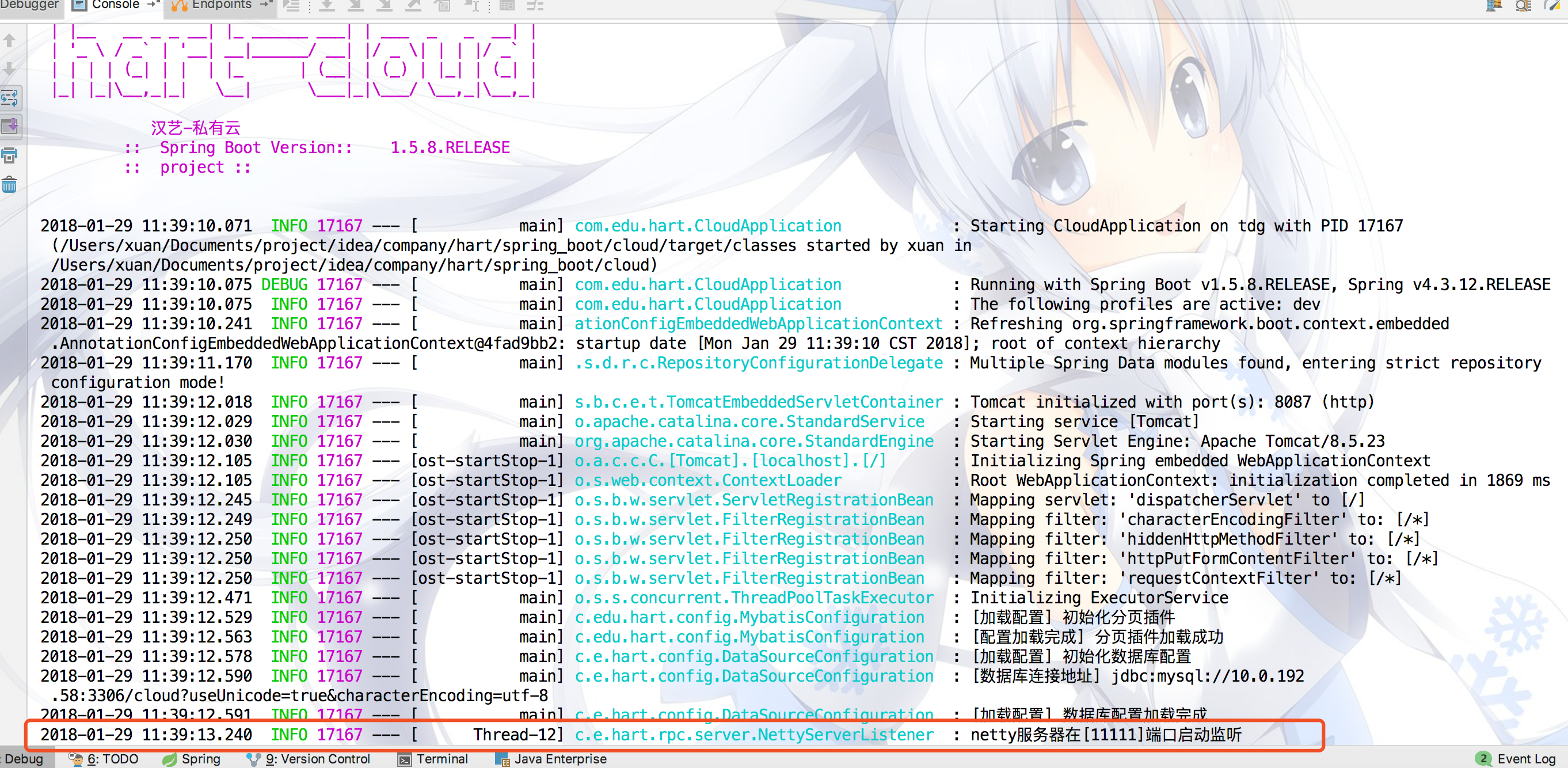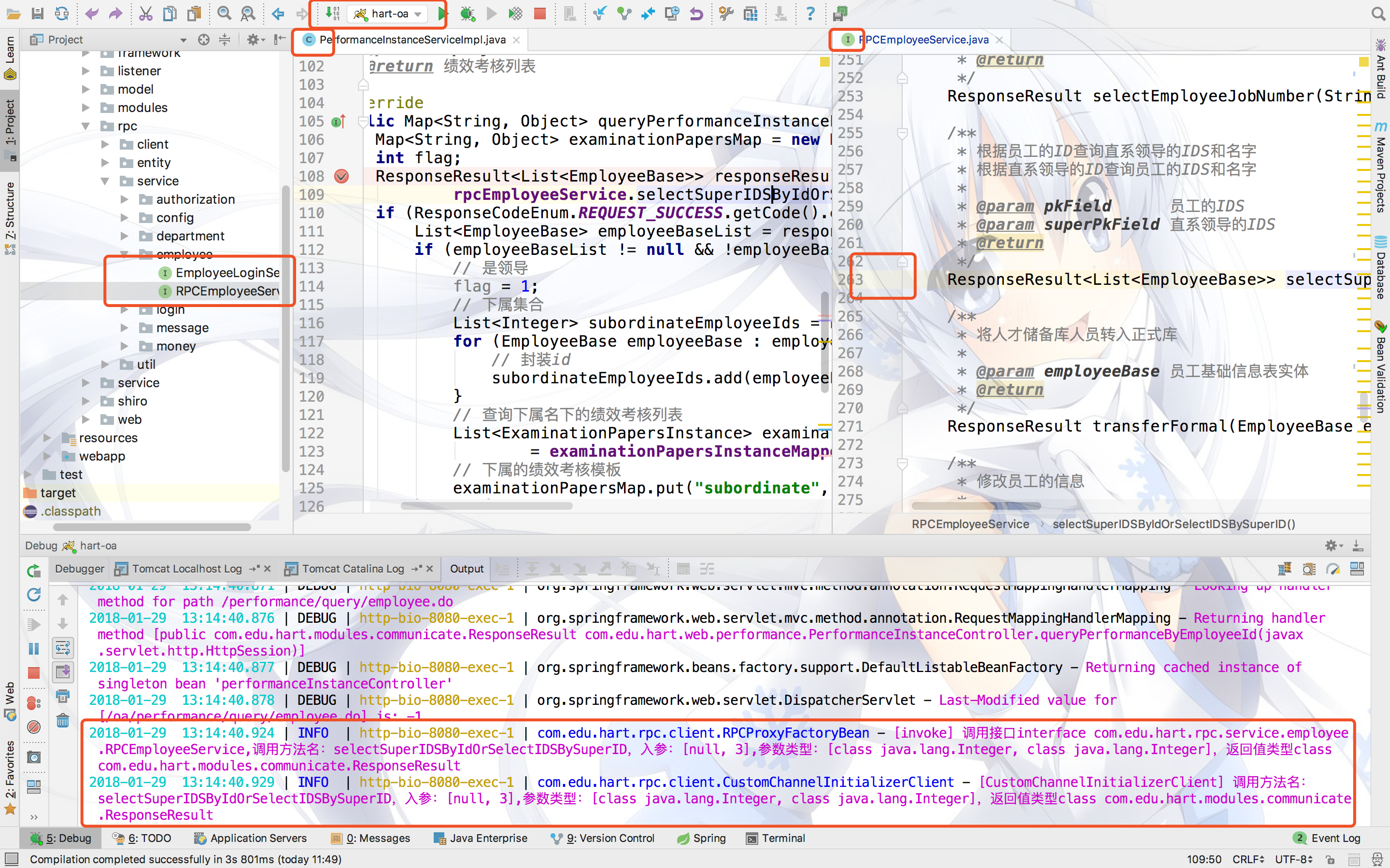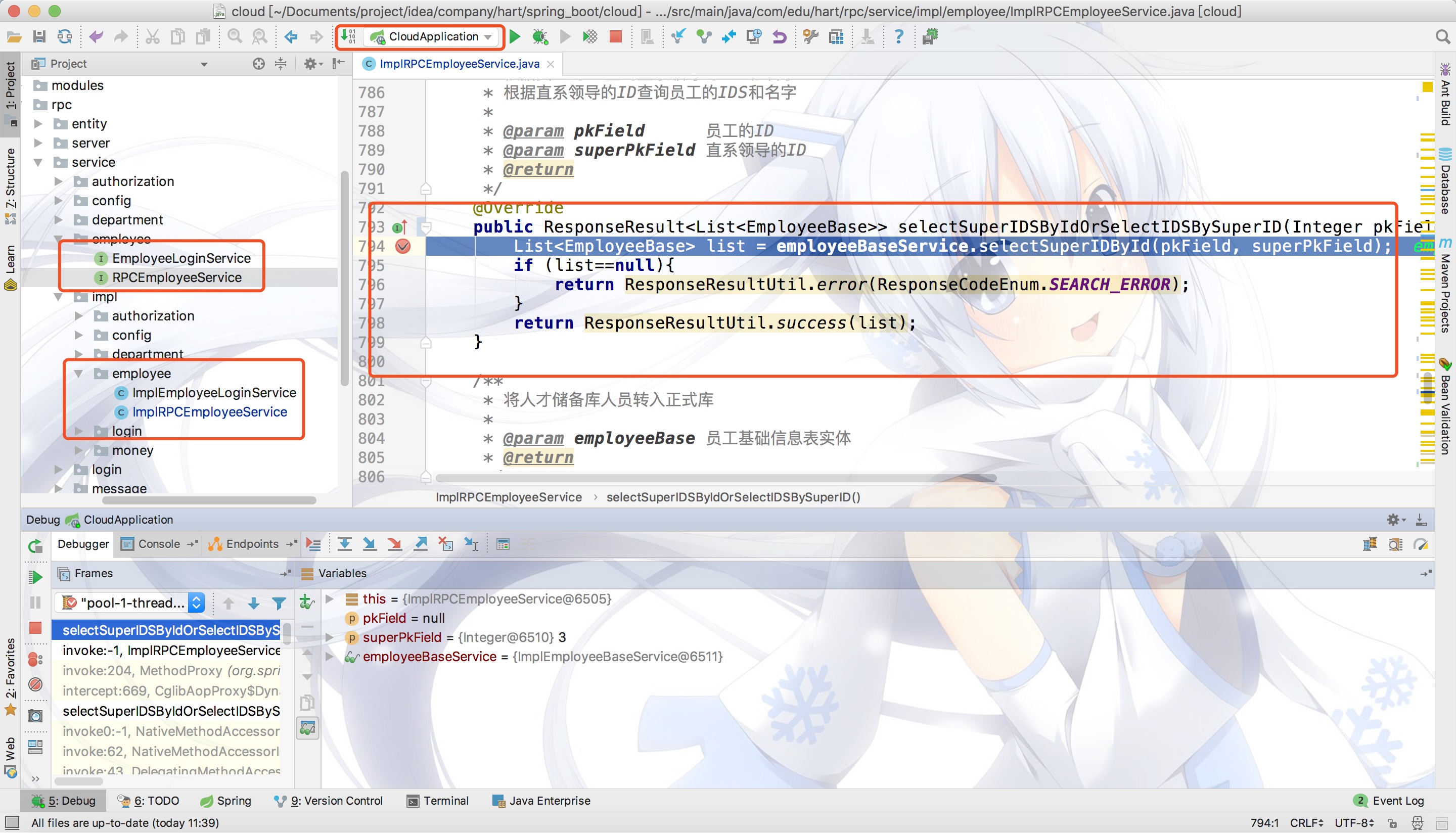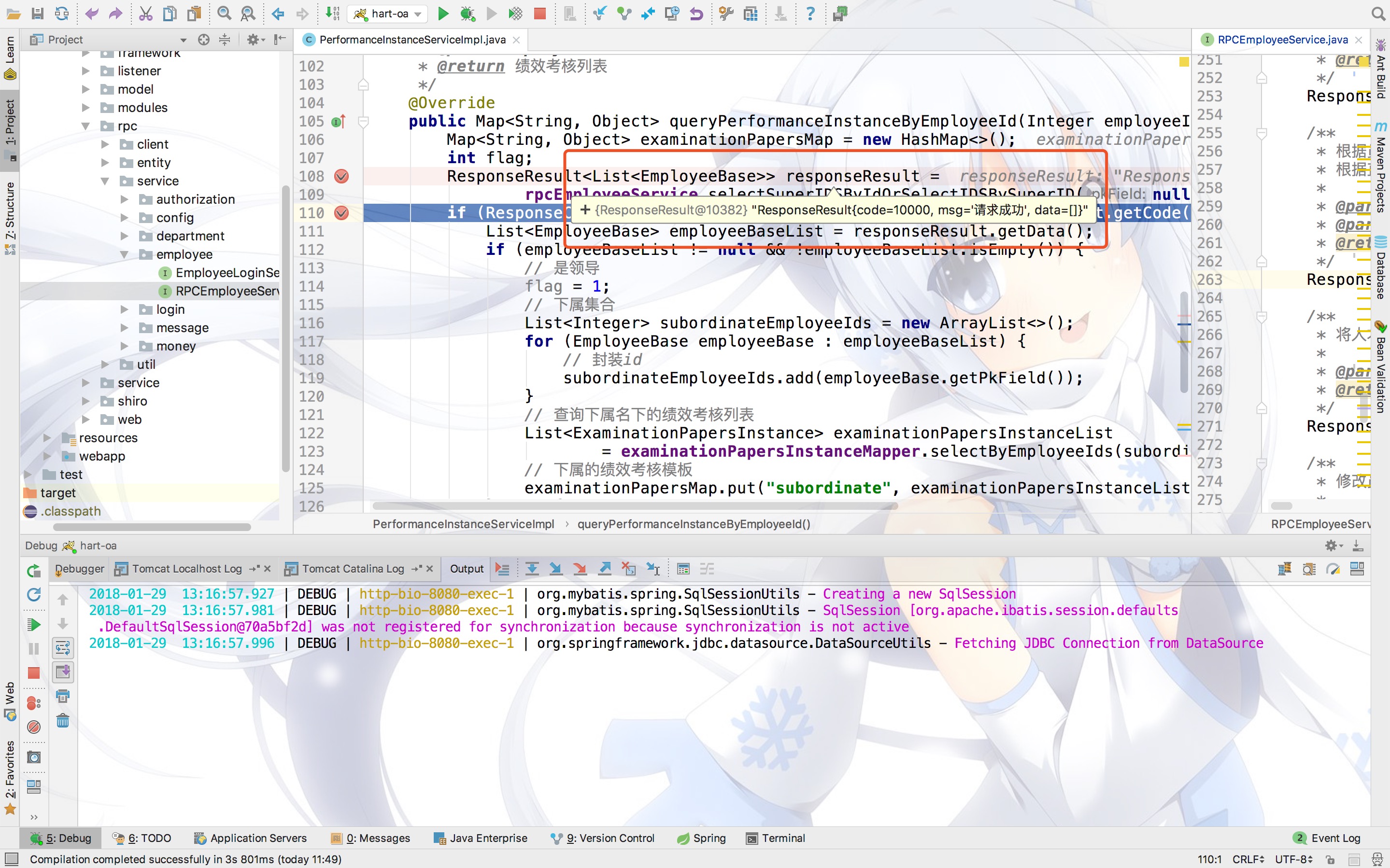Netty与Spring Boot的整合
最近有朋友向我询问一些Netty与SpringBoot整合的相关问题,这里,我就总结了一下基本整合流程,也就是说,这篇文章 ,默认大家是对netty与Spring,SpringMVC的整合是没有什么问题的。现在,就进入正题吧。
Server端:
总的来说,服务端还是比较简单的,自己一共写了三个核心类。分别是
- NettyServerListener:服务启动监听器
- ServerChannelHandlerAdapter:通道适配器,主要用于多线程共享
- RequestDispatcher:请求分排器
下面开始集成过程:
-
在pom.xml中添加以下依赖
<dependency> <groupId>io.netty</groupId> <artifactId>netty-all</artifactId> <version>5.0.0.Alpha2</version> </dependency> <dependency> <groupId>org.springframework.boot</groupId> <artifactId>spring-boot-configuration-processor</artifactId> <optional>true</optional> </dependency> -
让SpringBoot的启动类实现CommandLineRunner接口并重写run方法,比如我的启动类是CloudApplication.java
@SpringBootApplication public class CloudApplication implements CommandLineRunner { public static void main(String[] args) { SpringApplication.run(CloudApplication.class, args); } @Override public void run(String... strings) { } } -
创建类NettyServerListener.java
// 读取yml的一个配置类 import com.edu.hart.modules.constant.NettyConfig; // Netty连接信息配置类 import com.edu.hart.modules.constant.NettyConstant; // import com.edu.hart.rpc.util.ObjectCodec; import io.netty.bootstrap.ServerBootstrap; import io.netty.channel.ChannelFuture; import io.netty.channel.ChannelInitializer; import io.netty.channel.ChannelPipeline; import io.netty.channel.EventLoopGroup; import io.netty.channel.nio.NioEventLoopGroup; import io.netty.channel.socket.SocketChannel; import io.netty.channel.socket.nio.NioServerSocketChannel; import io.netty.handler.codec.LengthFieldBasedFrameDecoder; import io.netty.handler.codec.LengthFieldPrepender; import org.slf4j.Logger; import org.slf4j.LoggerFactory; import org.springframework.stereotype.Component; import javax.annotation.PreDestroy; import javax.annotation.Resource; /** * 服务启动监听器 * * @author 叶云轩 */ @Component public class NettyServerListener { /** * NettyServerListener 日志输出器 * * @author 叶云轩 create by 2017/10/31 18:05 */ private static final Logger LOGGER = LoggerFactory.getLogger(NettyServerListener.class); /** * 创建bootstrap */ ServerBootstrap serverBootstrap = new ServerBootstrap(); /** * BOSS */ EventLoopGroup boss = new NioEventLoopGroup(); /** * Worker */ EventLoopGroup work = new NioEventLoopGroup(); /** * 通道适配器 */ @Resource private ServerChannelHandlerAdapter channelHandlerAdapter; /** * NETT服务器配置类 */ @Resource private NettyConfig nettyConfig; /** * 关闭服务器方法 */ @PreDestroy public void close() { LOGGER.info("关闭服务器...."); //优雅退出 boss.shutdownGracefully(); work.shutdownGracefully(); } /** * 开启及服务线程 */ public void start() { // 从配置文件中(application.yml)获取服务端监听端口号 int port = nettyConfig.getPort(); serverBootstrap.group(boss, work) .channel(NioServerSocketChannel.class) .option(ChannelOption.SO_BACKLOG, 100) .handler(new LoggingHandler(LogLevel.INFO)); try { //设置事件处理 serverBootstrap.childHandler(new ChannelInitializer<SocketChannel>() { @Override protected void initChannel(SocketChannel ch) throws Exception { ChannelPipeline pipeline = ch.pipeline(); pipeline.addLast(new LengthFieldBasedFrameDecoder(nettyConfig.getMaxFrameLength() , 0, 2, 0, 2)); pipeline.addLast(new LengthFieldPrepender(2)); pipeline.addLast(new ObjectCodec()); pipeline.addLast(channelHandlerAdapter); } }); LOGGER.info("netty服务器在[{}]端口启动监听", port); ChannelFuture f = serverBootstrap.bind(port).sync(); f.channel().closeFuture().sync(); } catch (InterruptedException e) { LOGGER.info("[出现异常] 释放资源"); boss.shutdownGracefully(); work.shutdownGracefully(); } } } -
创建类ServerChannelHandlerAdapter.java - 通道适配器
// 记录调用方法的元信息的类 import com.edu.hart.rpc.entity.MethodInvokeMeta; import io.netty.channel.ChannelHandler.Sharable; import io.netty.channel.ChannelHandlerAdapter; import io.netty.channel.ChannelHandlerContext; import org.slf4j.Logger; import org.slf4j.LoggerFactory; import org.springframework.stereotype.Component; import javax.annotation.Resource; /** * 多线程共享 */ @Component @Sharable public class ServerChannelHandlerAdapter extends ChannelHandlerAdapter { /** * 日志处理 */ private Logger logger = LoggerFactory.getLogger(ServerChannelHandlerAdapter.class); /** * 注入请求分排器 */ @Resource private RequestDispatcher dispatcher; @Override public void exceptionCaught(ChannelHandlerContext ctx, Throwable cause) { cause.printStackTrace(); ctx.close(); } @Override public void channelRead(ChannelHandlerContext ctx, Object msg) { MethodInvokeMeta invokeMeta = (MethodInvokeMeta) msg; // 屏蔽toString()方法 if (invokeMeta.getMethodName().endsWith("toString()") && !"class java.lang.String".equals(invokeMeta.getReturnType().toString())) logger.info("客户端传入参数 :{},返回值:{}", invokeMeta.getArgs(), invokeMeta.getReturnType()); dispatcher.dispatcher(ctx, invokeMeta); } } -
RequestDispatcher.java
// 封装的返回信息枚举类 import com.edu.hart.modules.communicate.ResponseCodeEnum; // 封装的返回信息实体类 import com.edu.hart.modules.communicate.ResponseResult; // 封装的连接常量类 import com.edu.hart.modules.constant.NettyConstant; // 记录元方法信息的实体类 import com.edu.hart.rpc.entity.MethodInvokeMeta; // 对于返回值为空的一个处理 import com.edu.hart.rpc.entity.NullWritable; // 封装的返回信息实体工具类 import com.edu.hart.rpc.util.ResponseResultUtil; import io.netty.channel.ChannelFuture; import io.netty.channel.ChannelFutureListener; import io.netty.channel.ChannelHandlerContext; import org.springframework.beans.BeansException; import org.springframework.context.ApplicationContext; import org.springframework.context.ApplicationContextAware; import org.springframework.stereotype.Component; import java.lang.reflect.Method; import java.util.concurrent.ExecutorService; import java.util.concurrent.Executors; /** * 请求分排器 */ @Component public class RequestDispatcher implements ApplicationContextAware { private ExecutorService executorService = Executors.newFixedThreadPool(NettyConstant.getMaxThreads()); private ApplicationContext app; /** * 发送 * * @param ctx * @param invokeMeta */ public void dispatcher(final ChannelHandlerContext ctx, final MethodInvokeMeta invokeMeta) { executorService.submit(() -> { ChannelFuture f = null; try { Class<?> interfaceClass = invokeMeta.getInterfaceClass(); String name = invokeMeta.getMethodName(); Object[] args = invokeMeta.getArgs(); Class<?>[] parameterTypes = invokeMeta.getParameterTypes(); Object targetObject = app.getBean(interfaceClass); Method method = targetObject.getClass().getMethod(name, parameterTypes); Object obj = method.invoke(targetObject, args); if (obj == null) { f = ctx.writeAndFlush(NullWritable.nullWritable()); } else { f = ctx.writeAndFlush(obj); } f.addListener(ChannelFutureListener.CLOSE); } catch (Exception e) { ResponseResult error = ResponseResultUtil.error(ResponseCodeEnum.SERVER_ERROR); f = ctx.writeAndFlush(error); } finally { f.addListener(ChannelFutureListener.CLOSE); } }); } /** * 加载当前application.xml * * @param ctx * @throws BeansException */ public void setApplicationContext(ApplicationContext ctx) throws BeansException { this.app = ctx; } } -
application.yml文件中对于netty的一个配置
netty: port: 11111 -
NettyConfig.java
import org.springframework.boot.context.properties.ConfigurationProperties; import org.springframework.stereotype.Component; /** * 读取yml配置文件中的信息 * Created by 叶云轩 on 2017/10/31 - 18:38 * Concat [email protected] */ @Component @ConfigurationProperties(prefix = "netty") public class NettyConfig { private int port; public int getPort() { return port; } public void setPort(int port) { this.port = port; } } -
NettyConstanct.java
import org.springframework.stereotype.Component; /** * Netty服务器常量 * Created by 叶云轩 on 2017/10/31 - 17:47 * Concat [email protected] */ @Component public class NettyConstant { /** * 最大线程量 */ private static final int MAX_THREADS = 1024; /** * 数据包最大长度 */ private static final int MAX_FRAME_LENGTH = 65535; public static int getMaxFrameLength() { return MAX_FRAME_LENGTH; } public static int getMaxThreads() { return MAX_THREADS; } }至此,netty服务端算是与SpringBoot整合成功。那么看一下启动情况吧。

Client端:
Client我感觉要比Server端要麻烦一点。这里还是先给出核心类吧。
- NettyClient : netty客户端
- ClientChannelHandlerAdapter : 客户端通道适配器
- CustomChannelInitalizer:自定义通道初始化工具
- RPCProxyFactoryBean:RPC通信代理工厂
在Client端里。SpringBoot的启动类要继承SpringBootServletInitializer这个类,并覆盖SpringApplicationBuilder方法
import org.springframework.boot.SpringApplication;
import org.springframework.boot.autoconfigure.SpringBootApplication;
import org.springframework.boot.builder.SpringApplicationBuilder;
import org.springframework.boot.web.support.SpringBootServletInitializer;
@SpringBootApplication
public class OaApplication extends SpringBootServletInitializer {
public static void main(String[] args) {
SpringApplication.run(OaApplication.class, args);
}
@Override
protected SpringApplicationBuilder configure(SpringApplicationBuilder builder) {
return builder.sources(OaApplication.class);
}
}
-
NettyClient.java
// 记录元方法信息的实体类 import com.edu.hart.rpc.entity.MethodInvokeMeta; import io.netty.bootstrap.Bootstrap; import io.netty.channel.ChannelFuture; import io.netty.channel.EventLoopGroup; import io.netty.channel.nio.NioEventLoopGroup; import io.netty.channel.socket.nio.NioSocketChannel; import org.slf4j.Logger; import org.slf4j.LoggerFactory; import javax.management.MBeanServer; /** * 客户端发送类 * Created by 叶云轩 on 2017/6/16-16:58 * Concat [email protected] */ public class NettyClient { private Logger logger = LoggerFactory.getLogger(MBeanServer.class); private Bootstrap bootstrap; private EventLoopGroup worker; private int port; private String url; private int MAX_RETRY_TIMES = 10; public NettyClient(String url, int port) { this.url = url; this.port = port; bootstrap = new Bootstrap(); worker = new NioEventLoopGroup(); bootstrap.group(worker); bootstrap.channel(NioSocketChannel.class); } public void close() { logger.info("关闭资源"); worker.shutdownGracefully(); } public Object remoteCall(final MethodInvokeMeta cmd, int retry) { try { CustomChannelInitializerClient customChannelInitializer = new CustomChannelInitializerClient(cmd); bootstrap.handler(customChannelInitializer); ChannelFuture sync = bootstrap.connect(url, port).sync(); sync.channel().closeFuture().sync(); Object response = customChannelInitializer.getResponse(); return response; } catch (InterruptedException e) { retry++; if (retry > MAX_RETRY_TIMES) { throw new RuntimeException("调用Wrong"); } else { try { Thread.sleep(100); } catch (InterruptedException e1) { e1.printStackTrace(); } logger.info("第{}次尝试....失败", retry); return remoteCall(cmd, retry); } } } } -
ClientChannelHandlerAdapter.java
import com.edu.hart.rpc.entity.MethodInvokeMeta; import io.netty.channel.ChannelHandlerAdapter; import io.netty.channel.ChannelHandlerContext; import org.slf4j.Logger; import org.slf4j.LoggerFactory; /** * Created by 叶云轩 on 2017/6/16-17:03 * Concat [email protected] */ public class ClientChannelHandlerAdapter extends ChannelHandlerAdapter { private Logger logger = LoggerFactory.getLogger(ClientChannelHandlerAdapter.class); private MethodInvokeMeta methodInvokeMeta; private CustomChannelInitializerClient channelInitializerClient; public ClientChannelHandlerAdapter(MethodInvokeMeta methodInvokeMeta, CustomChannelInitializerClient channelInitializerClient) { this.methodInvokeMeta = methodInvokeMeta; this.channelInitializerClient = channelInitializerClient; } @Override public void exceptionCaught(ChannelHandlerContext ctx, Throwable cause) throws Exception { logger.info("客户端出异常了,异常信息:{}", cause.getMessage()); cause.printStackTrace(); ctx.close(); } @Override public void channelActive(ChannelHandlerContext ctx) throws Exception { if (methodInvokeMeta.getMethodName().endsWith("toString") && !"class java.lang.String".equals(methodInvokeMeta.getReturnType().toString())) logger.info("客户端发送信息参数:{},信息返回值类型:{}", methodInvokeMeta.getArgs(), methodInvokeMeta.getReturnType()); ctx.writeAndFlush(methodInvokeMeta); } @Override public void channelRead(ChannelHandlerContext ctx, Object msg) throws Exception { channelInitializerClient.setResponse(msg); } } -
CustomChannelInitializerClient.java
import com.edu.hart.rpc.entity.MethodInvokeMeta; import com.edu.hart.rpc.entity.NullWritable; import com.edu.hart.rpc.util.ObjectCodec; import io.netty.channel.ChannelInitializer; import io.netty.channel.ChannelPipeline; import io.netty.channel.socket.SocketChannel; import io.netty.handler.codec.LengthFieldBasedFrameDecoder; import io.netty.handler.codec.LengthFieldPrepender; import org.slf4j.Logger; import org.slf4j.LoggerFactory;
/**
Created by 叶云轩 on 2017/6/16-15:01
Concat [email protected]
*/
public class CustomChannelInitializerClient extends ChannelInitializer {
private Logger logger = LoggerFactory.getLogger(CustomChannelInitializerClient.class);
private MethodInvokeMeta methodInvokeMeta;
private Object response;
public CustomChannelInitializerClient(MethodInvokeMeta methodInvokeMeta) {
if (!"toString".equals(methodInvokeMeta.getMethodName())) {
logger.info("[CustomChannelInitializerClient] 调用方法名:{},入参:{},参数类型:{},返回值类型{}"
, methodInvokeMeta.getMethodName()
, methodInvokeMeta.getArgs()
, methodInvokeMeta.getParameterTypes()
, methodInvokeMeta.getReturnType());
}
this.methodInvokeMeta = methodInvokeMeta;
}
public Object getResponse() {
if (response instanceof NullWritable) {
return null;
}
return response;
}
public void setResponse(Object response) {
this.response = response;
}
@Override
protected void initChannel(SocketChannel ch) {
ChannelPipeline pipeline = ch.pipeline();
pipeline.addLast(new LengthFieldPrepender(2));
pipeline.addLast(new LengthFieldBasedFrameDecoder(1024 * 1024, 0, 2, 0, 2));
pipeline.addLast(new ObjectCodec());
pipeline.addLast(new ClientChannelHandlerAdapter(methodInvokeMeta, this));
}
}4. RPCProxyFactoryBean.java
```java
import com.edu.hart.rpc.entity.MethodInvokeMeta;
import com.edu.hart.rpc.util.WrapMethodUtils;
import org.slf4j.Logger;
import org.slf4j.LoggerFactory;
import org.springframework.beans.factory.config.AbstractFactoryBean;
import java.lang.reflect.InvocationHandler;
import java.lang.reflect.Method;
import java.lang.reflect.Proxy;
/**
* Created by 叶云轩 on 2017/6/16-17:16
* Concat [email protected]
*/
public class RPCProxyFactoryBean extends AbstractFactoryBean<Object> implements InvocationHandler {
private Logger logger = LoggerFactory.getLogger(RPCProxyFactoryBean.class);
private Class interfaceClass;
private NettyClient nettyClient;
@Override
public Class<?> getObjectType() {
return interfaceClass;
}
@Override
protected Object createInstance() throws Exception {
logger.info("[代理工厂] 初始化代理Bean : {}", interfaceClass);
return Proxy.newProxyInstance(interfaceClass.getClassLoader(), new Class[]{interfaceClass}, this);
}
@Override
public Object invoke(Object proxy, Method method, Object[] args) {
final MethodInvokeMeta methodInvokeMeta = WrapMethodUtils.readMethod(interfaceClass, method, args);
if (!methodInvokeMeta.getMethodName().equals("toString")) {
logger.info("[invoke] 调用接口{},调用方法名:{},入参:{},参数类型:{},返回值类型{}",
methodInvokeMeta.getInterfaceClass(), methodInvokeMeta.getMethodName()
, methodInvokeMeta.getArgs(), methodInvokeMeta.getParameterTypes(), methodInvokeMeta.getReturnType());
}
return nettyClient.remoteCall(methodInvokeMeta, 0);
}
public void setInterfaceClass(Class interfaceClass) {
this.interfaceClass = interfaceClass;
}
public void setNettyClient(NettyClient nettyClient) {
this.nettyClient = nettyClient;
}
}至此,netty-client与SpringBoot的集成了算完毕了。同样 ,在netty-client中也要加入相应的依赖
不过上面server与client使用了一些公共的类和工具。下面也给列举中出来。
MethodInvokeMeta.java
import org.springframework.stereotype.Component;
import java.io.Serializable;
/**
* 记录调用方法的元信息
* Created by 叶云轩 on 2017/6/7-15:41
* Concat [email protected]
*/
@Component
public class MethodInvokeMeta implements Serializable {
private static final long serialVersionUID = 8379109667714148890L;
//接口
private Class<?> interfaceClass;
//方法名
private String methodName;
//参数
private Object[] args;
//返回值类型
private Class<?> returnType;
//参数类型
private Class<?>[] parameterTypes;
public Object[] getArgs() {
return args;
}
public void setArgs(Object[] args) {
this.args = args;
}
public Class<?> getInterfaceClass() {
return interfaceClass;
}
public void setInterfaceClass(Class<?> interfaceClass) {
this.interfaceClass = interfaceClass;
}
public String getMethodName() {
return methodName;
}
public void setMethodName(String methodName) {
this.methodName = methodName;
}
public Class[] getParameterTypes() {
return parameterTypes;
}
public void setParameterTypes(Class<?>[] parameterTypes) {
this.parameterTypes = parameterTypes;
}
public Class getReturnType() {
return returnType;
}
public void setReturnType(Class returnType) {
this.returnType = returnType;
}
}NullWritable.java
import java.io.Serializable;
/**
* 服务器可能返回空的处理
* Created by 叶云轩 on 2017/6/16-16:46
* Concat [email protected]
*/
public class NullWritable implements Serializable {
private static final long serialVersionUID = -8191640400484155111L;
private static NullWritable instance = new NullWritable();
private NullWritable() {
}
public static NullWritable nullWritable() {
return instance;
}
}ObjectCodec.java
import io.netty.buffer.ByteBuf;
import io.netty.buffer.Unpooled;
import io.netty.channel.ChannelHandlerContext;
import io.netty.handler.codec.MessageToMessageCodec;
import java.util.List;
public class ObjectCodec extends MessageToMessageCodec<ByteBuf, Object> {
@Override
protected void encode(ChannelHandlerContext ctx, Object msg, List<Object> out) {
byte[] data = ObjectSerializerUtils.serilizer(msg);
ByteBuf buf = Unpooled.buffer();
buf.writeBytes(data);
out.add(buf);
}
@Override
protected void decode(ChannelHandlerContext ctx, ByteBuf msg, List<Object> out) {
byte[] bytes = new byte[msg.readableBytes()];
msg.readBytes(bytes);
Object deSerilizer = ObjectSerializerUtils.deSerilizer(bytes);
out.add(deSerilizer);
}
}ObjectSerializerUtils.java
package com.edu.hart.rpc.util;
import org.slf4j.Logger;
import org.slf4j.LoggerFactory;
import java.io.*;
/**
* 对象序列化工具
*/
public class ObjectSerializerUtils {
private static final Logger logger = LoggerFactory.getLogger(ObjectSerializerUtils.class);
/**
* 反序列化
*
* @param data
* @return
*/
public static Object deSerilizer(byte[] data) {
if (data != null && data.length > 0) {
try {
ByteArrayInputStream bis = new ByteArrayInputStream(data);
ObjectInputStream ois = new ObjectInputStream(bis);
return ois.readObject();
} catch (Exception e) {
logger.info("[异常信息] {}", e.getMessage());
e.printStackTrace();
}
return null;
} else {
logger.info("[反序列化] 入参为空");
return null;
}
}
/**
* 序列化对象
*
* @param obj
* @return
*/
public static byte[] serilizer(Object obj) {
if (obj != null) {
try {
ByteArrayOutputStream bos = new ByteArrayOutputStream();
ObjectOutputStream oos = new ObjectOutputStream(bos);
oos.writeObject(obj);
oos.flush();
oos.close();
return bos.toByteArray();
} catch (IOException e) {
e.printStackTrace();
}
return null;
} else {
return null;
}
}
}下面主要是用于Client端的:
NettyBeanSacnner.java
import com.edu.hart.rpc.client.RPCProxyFactoryBean;
import org.springframework.beans.BeansException;
import org.springframework.beans.factory.config.BeanFactoryPostProcessor;
import org.springframework.beans.factory.config.ConfigurableListableBeanFactory;
import org.springframework.beans.factory.support.BeanDefinitionBuilder;
import org.springframework.beans.factory.support.DefaultListableBeanFactory;
import java.util.List;
/**
* 动态加载代理bean到Spring bean工厂
*/
public class NettyBeanScanner implements BeanFactoryPostProcessor {
private DefaultListableBeanFactory beanFactory;
private String basePackage;
private String clientName;
public NettyBeanScanner(String basePackage, String clientName) {
this.basePackage = basePackage;
this.clientName = clientName;
}
/**
* 注册Bean到Spring的bean工厂
*/
public void postProcessBeanFactory(ConfigurableListableBeanFactory beanFactory) throws BeansException {
this.beanFactory = (DefaultListableBeanFactory) beanFactory;
// 加载远程服务的接口
List<String> resolverClass = PackageClassUtils.resolver(basePackage);
for (String clazz : resolverClass) {
String simpleName;
if (clazz.lastIndexOf('.') != -1) {
simpleName = clazz.substring(clazz.lastIndexOf('.') + 1);
} else {
simpleName = clazz;
}
BeanDefinitionBuilder gd = BeanDefinitionBuilder.genericBeanDefinition(RPCProxyFactoryBean.class);
gd.addPropertyValue("interfaceClass", clazz);
gd.addPropertyReference("nettyClient", clientName);
this.beanFactory.registerBeanDefinition(simpleName, gd.getRawBeanDefinition());
}
}
}PackageClassUtils.java
这个类要说一下,主要是用来加载Server对应的接口的。因为在Client中RPC接口没有实现类,所以要自己将这些接口加载到Spring工厂里面。但是现在有个问题就是需要使用
SpringBoot中application.yml
basePackage: com.edu.hart.rpc.service.login;com.edu.hart.rpc.service.employee;com.edu.hart.rpc.service.authorization;- 这样的方式来加载,使用通配符的时候会加载不到,这个问题我还没有解决。
import org.slf4j.Logger;
import org.slf4j.LoggerFactory;
import java.io.File;
import java.util.ArrayList;
import java.util.List;
/**
* 字节文件加载
*/
public class PackageClassUtils {
private final static Logger LOGGER = LoggerFactory.getLogger(PackageClassUtils.class);
/**
* 解析包参数
*
* @param basePackage 包名
* @return 包名字符串集合
*/
public static List<String> resolver(String basePackage) {
//以";"分割开多个包名
String[] splitFHs = basePackage.split(";");
List<String> classStrs = new ArrayList<>();
//s: com.yyx.util.*
for (String s : splitFHs) {
LOGGER.info("[加载类目录] {}", s);
//路径中是否存在".*" com.yyx.util.*
boolean contains = s.contains(".*");
if (contains) {
//截断星号 com.yyx.util
String filePathStr = s.substring(0, s.lastIndexOf(".*"));
//组装路径 com/yyx/util
String filePath = filePathStr.replaceAll("\\.", "/");
//获取路径 xxx/classes/com/yyx/util
File file = new File(PackageClassUtils.class.getResource("/").getPath() + "/" + filePath);
//获取目录下获取文件
getAllFile(filePathStr, file, classStrs);
} else {
String filePath = s.replaceAll("\\.", "/");
File file = new File(PackageClassUtils.class.getResource("/").getPath() + "/" + filePath);
classStrs = getClassReferenceList(classStrs, file, s);
}
}
return classStrs;
}
/**
* 添加全限定类名到集合
*
* @param classStrs 集合
* @return 类名集合
*/
private static List<String> getClassReferenceList(List<String> classStrs, File file, String s) {
File[] listFiles = file.listFiles();
if (listFiles != null && listFiles.length != 0) {
for (File file2 : listFiles) {
if (file2.isFile()) {
String name = file2.getName();
String fileName = s + "." + name.substring(0, name.lastIndexOf('.'));
LOGGER.info("[加载完成] 类文件:{}", fileName);
classStrs.add(fileName);
}
}
}
return classStrs;
}
/**
* 获取一个目录下的所有文件
*
* @param s
* @param file
* @param classStrs
*/
private static void getAllFile(String s, File file, List<String> classStrs) {
if (file.isDirectory()) {
File[] files = file.listFiles();
if (files != null)
for (File file1 : files) {
getAllFile(s, file1, classStrs);
}
} else {
String path = file.getPath();
String cleanPath = path.replaceAll("/", ".");
String fileName = cleanPath.substring(cleanPath.indexOf(s), cleanPath.length());
LOGGER.info("[加载完成] 类文件:{}", fileName);
classStrs.add(fileName);
}
}
}RemoteMethodInvokeUtil.java
import com.edu.hart.rpc.entity.MethodInvokeMeta;
import org.springframework.beans.BeansException;
import org.springframework.context.ApplicationContext;
import org.springframework.context.ApplicationContextAware;
import java.lang.reflect.InvocationTargetException;
import java.lang.reflect.Method;
/**
* 消息处理类
* Created by 叶云轩 on 2017/6/7-15:49
* Concat [email protected]
*/
public class RemoteMethodInvokeUtil implements ApplicationContextAware {
private ApplicationContext applicationContext;
public Object processMethod(MethodInvokeMeta methodInvokeMeta) throws InvocationTargetException, IllegalAccessException {
Class interfaceClass = methodInvokeMeta.getInterfaceClass();
Object bean = applicationContext.getBean(interfaceClass);
Method[] declaredMethods = interfaceClass.getDeclaredMethods();
Method method = null;
for (Method declaredMethod : declaredMethods) {
if (methodInvokeMeta.getMethodName().equals(declaredMethod.getName())) {
method = declaredMethod;
}
}
Object invoke = method.invoke(bean, methodInvokeMeta.getArgs());
return invoke;
}
@Override
public void setApplicationContext(ApplicationContext app) throws BeansException {
applicationContext = app;
}
}WrapMethodUtils.java
下面的这些类我也会用在与前台通信时使用:
ResponseEnum.java
ResponseResult.java
import java.io.Serializable;
/**
* 数据返回实体封装
* <p>
* Created by 叶云轩 on 2017/6/13-11:38
* Concat [email protected]
*
* @param <T> 通用变量
*/
public class ResponseResult<T> implements Serializable {
private static final long serialVersionUID = -3411174924856108156L;
/**
* 服务器响应码
*/
private Integer code;
/**
* 服务器响应说明
*/
private String msg;
/**
* 服务器响应数据
*/
private T data;
public ResponseResult() {
}
@Override
public boolean equals(Object o) {
if (this == o) return true;
if (o == null || getClass() != o.getClass()) return false;
ResponseResult<?> that = (ResponseResult<?>) o;
return (code != null ? code.equals(that.code) : that.code == null) && (msg != null ? msg.equals(that.msg) : that.msg == null) && (data != null ? data.equals(that.data) : that.data == null);
}
public Integer getCode() {
return code;
}
public void setCode(Integer code) {
this.code = code;
}
public T getData() {
return data;
}
public void setData(T data) {
this.data = data;
}
public String getMsg() {
return msg;
}
public void setMsg(String msg) {
this.msg = msg;
}
@Override
public int hashCode() {
int result = code != null ? code.hashCode() : 0;
result = 31 * result
+ (msg != null ? msg.hashCode() : 0);
result = 31 * result + (data != null ? data.hashCode() : 0);
return result;
}
@Override
public String toString() {
return "ResponseResult{"
+ "code="
+ code
+ ", msg='"
+ msg
+ '\''
+ ", data="
+ data
+ '}';
}
}ResponseResultUtil.java
import com.edu.hart.modules.communicate.ResponseCodeEnum;
import com.edu.hart.modules.communicate.ResponseResult;
/**
* 返回结果工具类
* Created by 叶云轩 on 2017/5/29-10:37
* Concat [email protected]
*/
public class ResponseResultUtil {
/**
* 请求失败返回的数据结构
*
* @param responseCodeEnum 返回信息枚举类
* @return 结果集
*/
public static ResponseResult error(ResponseCodeEnum responseCodeEnum) {
ResponseResult ResponseResult = new ResponseResult();
ResponseResult.setMsg(responseCodeEnum.getMsg());
ResponseResult.setCode(responseCodeEnum.getCode());
ResponseResult.setData(null);
return ResponseResult;
}
/**
* 没有结果集的返回数据结构
*
* @return 结果集
*/
public static ResponseResult success() {
return success(null);
}
/**
* 成功返回数据结构
*
* @param o 返回数据对象
* @return 返回结果集
*/
public static ResponseResult success(Object o) {
ResponseResult responseResult = new ResponseResult();
responseResult.setMsg(ResponseCodeEnum.REQUEST_SUCCESS.getMsg());
responseResult.setCode(ResponseCodeEnum.REQUEST_SUCCESS.getCode());
responseResult.setData(o);
return responseResult;
}
/**
* 判断是否成功
*
* @param responseResult 请求结果
* @return 判断结果
*/
public static boolean judgementSuccess(ResponseResult responseResult) {
return responseResult.getCode().equals(ResponseCodeEnum.REQUEST_SUCCESS.getCode());
}
}来,我们测试一下远程通信:
- Client调用Server的一个接口。可以看到在hart-oa项目中,RPCEmployeeService没有任何实现类,控制台中打印了方法的调用 以及入参信息

- Server断点监听到远程调用,CloudApplication项目为Server端,我们可以看到接收到来自hart-oa的一个请求,参数一致。在CloudApplication中进行相应的处理后,返回到Client(hart-oa)

- 返回信息到Client,可以看到我们(hart-oa)收到了来自CloudApplication的响应,结果是我们封装好的ResponseResult.

作者:叶云轩
原文:https://blog.csdn.net/yuanzhenwei521/article/details/79194275